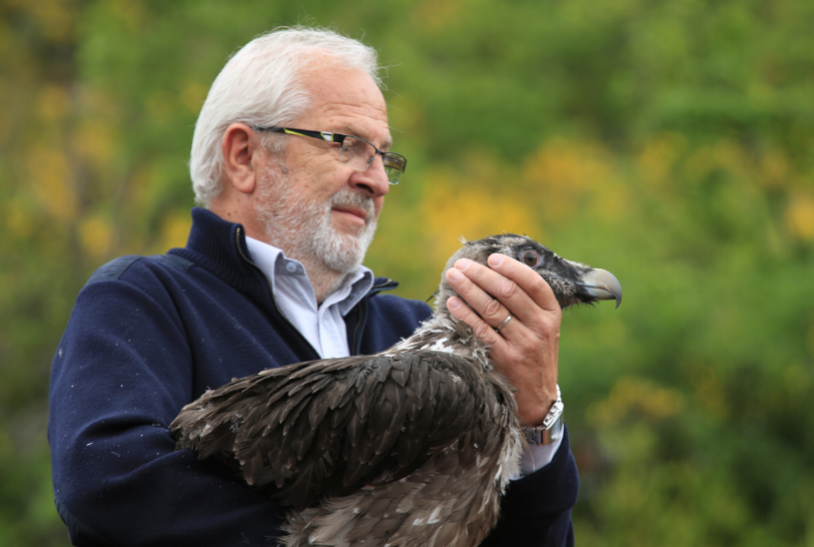
From the Sahel desert to the canyons of the Douro, it took male Egyptian vulture Douro 14 days to cover around 2800 km – the distance which separates breeding from wintering grounds. This bird flew an average of 200 km per day, reaching a maximum of 300 km on the 22nd of February. Here is a summary of this amazing journey and some curiosities about migration, a true wonder of nature, which never ceases to intrigue us.
Douro’s migration diary
24/1 After spending 4 months and a half in the Sahel desert, between Mauritania and Mali, Douro starts its first northward movement.
25/1 – 11/2 Preparing for its long journey ahead, Douro spends 18 days exploring the western Mauritania area, on the border of the Sahel desert, flying north and south between Atar and Sangrave, probably foraging for food.
12/2 Douro starts its full migration movement towards the north, flying around 250 km this day. From this day onward, Douro will not stop for one day to rest until he reaches the breeding grounds at the Douro canyon valley.
Curiosities about the route
The route Douro took northwards is different from the one he chose on the way South in August-September. This normally happens in bird migrations due to differences in wind direction. On the migration route to the south, between August and September, the birds certainly take advantage of the prevalent Northeast trade winds coming from Northern Europe, but the migration route is also pushed eastward by the African monsoon winds coming from the Atlantic Ocean. On the way back north, between January and March, the Harmattan winds move from the East towards the west, probably also affecting the migration route, which tends to move towards the coastline.
16/2 the route turns northeastward, along the Western Sahara coastline, which is around 100 km away. Coastines, mountain ranges and other geographical features can serve as an orientation tool for the birds.
18/2 Douro travels around 280 km on this day, crossing the border to Morocco and the lower Drá river wadi.
20/2 At noon, Douro crosses the Atlas mountains, passing close to Jbel Toubkal peak (the highest of Morocco, 4167 metres). And 2 hours later he passes Marrakech, flying more than 200 km in 10 hours. The Gibraltar strait is now only 480 km to the North.
22/2 Douro reaches the Gibraltar strait, having flown around 2300 km already, in 10 days. He does not stop here, and on the same day, at around 2 pm, he crosses the ocean, completing 300 km in one single day.
23/2 Douro passes right above the city centre of Seville.
24/2 Douro spends a few hours of the morning flying around, maybe foraging, and at around 10 am he restarts its journey, straight to the North, crossing fields and fields of olive trees around Almendralejo, passing Mérida and Cáceres, and stopping to spend the night when he reaches the Dehesa, south from the Sierra de Gata.
25/2 After crossing the Sierra de Gata, Douro reaches the Arribes del Duero Natural Park. He is home and will now recover from the long journey, foraging and gaining energy to start preparing for the coming breeding season.
26/2 Douro has visited its breeding territory already. It is probably a good strategy for an adult breeding bird to arrive very early in the season, to be able to defend its territory against other birds.
What will Douro do next?
The first Egyptian vultures of the season have been spotted since the 19th of February in the Douro region.
To find out what Douro is up to, follow him and the rest of the Egyptian vultures, here.
Who is Douro?
Douro, is one of the 5 Egyptian vultures, tagged within the LIFE Rupis project, and the first one to start migration this season. The other 4 birds (Rupis, Faia, Poiares and Bruçó) are still in the Sahel desert, in Africa, between Mali and Senegal.
You can learn more about how and why Douro was tagged with a GPS device, here.
Here is a short video of the release of Douro, after the tagging process, June 2017.
More about the LIFE Rupis project
The LIFE RUPIS project aims to implement actions to strengthen the populations of the Egyptian vulture (and the bonelli´s eagle) at the trans-border Douro, by reducing the mortality of these birds and increasing their breeding success. The Egyptian vulture is the smallest vulture in Europe, and it is classified as “Endangered” – in Europe its populations have declined by 50% over the last 40 years.
The project includes equipping electric lines against electrocution, several actions that aim to minimize the threat of illegal poisoning, targeted management of over 1,000 hectares of important habitats for the species and also the creation of a network of supplementary feeding stations.
The project is implemented by the VCF and partners, including SPEA (BirdLife in Portugal), ATN and Palombar (regional conservation organisations in NE Portugal), the Junta de Castilla y Leon & the Fundación Patrimonio Natural de Castilla Y León, the Portuguese electricity distributor EDP-D, the Portuguese statutory conservation agency ICNF and the Portuguese environmental police force (GNR), and is co-funded by the MAVA Foundation.



